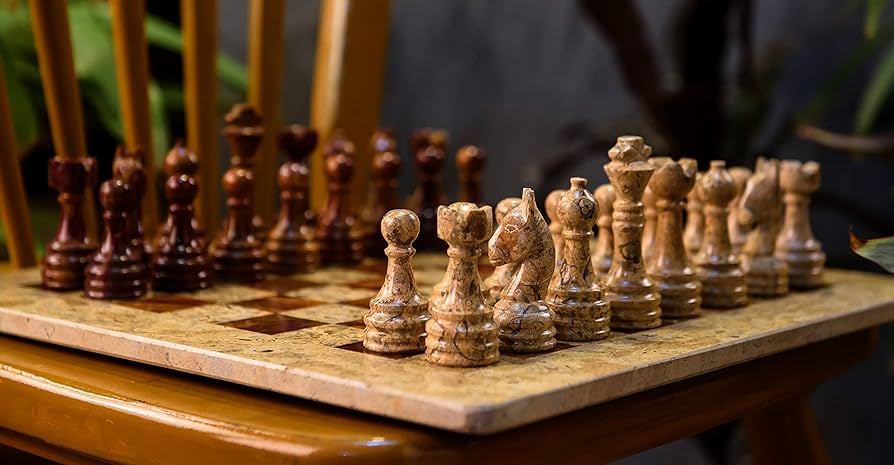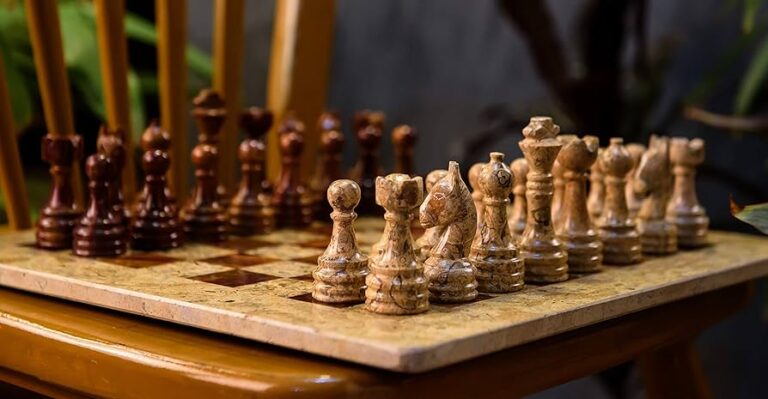A chess set is more than just a collection of pieces and a board; it is a symbol of strategy, intellect and centuries of tradition. The game of chess has fascinated people for generations, and the design of the chess set itself reflects the deep history and artistry behind this timeless pursuit. Whether crafted from fine wood, marble, glass or plastic, every chess set tells a story about the people who play it, the culture it represents and the enduring allure of the game.
A Brief History of the Chess Set
The chess set as we know it today has evolved over many centuries. The origins of chess can be traced back to ancient India, where a game called chaturanga was played around the 6th century. It spread to Persia, becoming known as shatranj, and later reached Europe through trade and conquest. Over time, the rules were refined, and the chess set adopted the familiar arrangement of 32 pieces on an 8×8 board.
Early chess sets varied widely in design. Pieces often reflected the culture of their region, with ornate carvings representing kings, warriors and animals. The modern appearance of the chess set was standardised in the mid-19th century with the introduction of the Staunton pattern, which quickly became the accepted design for competitive play. Its clear, balanced proportions and instantly recognisable shapes made it the ideal choice for players at all levels, ensuring that no matter where a match was played, both competitors could easily identify the pieces.
The Anatomy of a Chess Set
A chess set consists of 32 pieces divided equally between two opposing sides, usually referred to as white and black. Each side includes a king, a queen, two rooks, two bishops, two knights and eight pawns. The game is played on a chequered board of 64 squares, alternating light and dark colours. Every piece moves differently, and the challenge of chess lies in using the strengths of each piece strategically to capture the opponent’s king.
While the rules of chess are universally recognised, the style and material of the chess set can vary dramatically. Some players prefer traditional wooden sets with a polished finish, while others enjoy modern designs made from glass, metal or even acrylic. The materials used in a chess set can influence its feel and aesthetic, turning it into either a functional gaming tool or a decorative centrepiece for display.
The Art and Craft of Making a Chess Set
The process of creating a chess set often combines precision craftsmanship with artistic design. Wooden chess sets remain the most popular, particularly those carved from high-quality hardwoods such as rosewood, ebony or boxwood. Each piece is carefully shaped and balanced to ensure it feels comfortable in the hand and stands firmly on the board. The board itself is often inlaid with matching wood tones, creating a sense of harmony and elegance.
Luxury chess sets may be made from stone, marble or metal, appealing to collectors and enthusiasts who value artistry as much as playability. Some are even hand-painted or sculpted into intricate themes that transform the game into a work of art. The combination of craftsmanship and creativity makes the chess set one of the most enduring symbols of cultural expression.
Choosing the Right Chess Set
Selecting a chess set depends largely on how it will be used. For casual play at home, a simple and sturdy wooden or plastic chess set is ideal. These sets are durable, affordable and easy to handle, making them suitable for beginners and families. For those who play competitively or want a professional experience, a regulation-sized Staunton chess set is usually the best choice. The size, weight and proportions of the pieces are designed for comfort and clarity, ensuring smooth gameplay and visual consistency during tournaments.
Collectors often look for chess sets that reflect artistic or historical value. Antique chess sets, for instance, can be prized possessions that showcase exquisite craftsmanship from different eras. Some collectors focus on themed sets, where the pieces are designed around historical events, mythological figures or popular cultures. Whatever the purpose, the right chess set should reflect both practicality and personal taste.
The Chess Set as a Symbol of Intelligence and Culture
Throughout history, the chess set has symbolised intelligence, strategy and nobility. Playing chess has long been associated with critical thinking, problem-solving and foresight. Many great minds and leaders have been drawn to the game, finding in its strategic complexity a reflection of life’s own challenges. As such, owning a chess set is often seen as a mark of sophistication and intellectual curiosity.
Beyond the game itself, the chess set also carries cultural significance. It has inspired countless works of art, literature and film. The visual symmetry of the board and the hierarchy of the pieces mirror social structures, wars and power dynamics, making the chess set both a tool of recreation and a metaphor for human ambition. The board becomes a battlefield of ideas, and every move reflects a blend of logic and creativity.
Chess Sets in Modern Life
Even in the digital age, the appeal of the traditional chess set remains strong. While many people now play online through apps and websites, physical chess sets continue to hold a unique charm. There is something deeply satisfying about the tactile experience of moving real pieces across a solid board, feeling the weight of each decision quite literally in your hands.
Chess sets have also become popular as decorative items. A beautifully crafted chess set can add a touch of elegance to a living room, library or office. It can serve as both a conversation piece and a reminder of the enduring nature of thoughtful competition. For many, simply owning a chess set represents a connection to a global community of thinkers and strategists that transcends language and culture.
The Educational Value of a Chess Set
A chess set is also a powerful educational tool. Learning to play chess encourages patience, focus and forward thinking. It teaches children to plan ahead, weigh consequences and adapt to changing situations — skills that extend far beyond the board. Many schools and educational programmes use the chess set to develop problem-solving abilities and improve concentration in students.
In addition, playing with a physical chess set helps develop spatial awareness and memory. The visual and tactile elements of the board enhance understanding in ways that digital screens cannot fully replicate. This makes the chess set not only a source of entertainment but also an instrument for mental growth and development.
Collecting and Preserving Chess Sets
Collectors often view chess sets as valuable artefacts that capture moments in history. Each chess set, whether antique or modern, reflects the craftsmanship, materials and artistic preferences of its time. Preserving these sets requires care — wooden boards should be kept away from direct sunlight and moisture, while delicate materials like glass or stone should be handled with caution.
Some enthusiasts go further, curating collections that include travel chess sets, luxury display pieces and historically inspired reproductions. For these collectors, the appeal lies not just in the game but in the tangible representation of culture, artistry and human creativity. A well-maintained chess set can last for generations, becoming a cherished heirloom that connects family members through a shared appreciation of the game.
The Chess Set in Popular Culture
The image of the chess set has become iconic in popular culture. It appears in films, books and television as a symbol of intellect, conflict and strategy. Scenes featuring a chess set often convey tension and psychological depth, representing the careful calculation behind every decision. From quiet moments of reflection to grand matches between masters, the chess set continues to captivate audiences as a visual metaphor for intelligence and power.
In recent years, renewed interest in the game has sparked a surge in demand for high-quality chess sets. Many people have rediscovered the joy of sitting down with a real board, stepping away from screens to engage in slow, deliberate thought. The chess set, once seen as a traditional pastime, has found a place once again in modern homes as both a game and a statement of style.
Conclusion: The Enduring Legacy of the Chess Set
A chess set represents far more than a game. It embodies centuries of human thought, artistry and competition. From ancient civilisations to contemporary living rooms, the chess set has remained a constant companion for those who seek challenge, reflection and mastery. Its design may have evolved, but its essence has not changed — it remains a timeless symbol of strategic thinking and creative intelligence.
Whether used for serious play, casual enjoyment or aesthetic appreciation, the chess set continues to bridge generations and cultures. It stands as a reminder that true gamesmanship is not about chance but about foresight, patience and understanding. In a world that moves ever faster, the chess set endures as an invitation to slow down, think deeply and engage with the beauty of the mind at play.
















